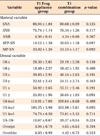1. Bolla E, Muratore F, Carano A, Bowman SJ. Evaluation of maxillary molar distalization with the distal jet: a comparison with other contemporary methods. Angle Orthod. 2002. 72:481–494.
2. Bondemark L, Karlsson I. Extraoral vs intraoral appliance for distal movement of maxillary first molars: a randomized controlled trial. Angle Orthod. 2005. 75:699–706.
3. Haydar S, Uner O. Comparison of Jones jig molar distalization appliance with extraoral traction. Am J Orthod Dentofacial Orthop. 2000. 117:49–53.

4. Angelieri F, de Almeida RR, Janson G, Castanha Henriques JF, Pinzan A. Comparison of the effects produced by headgear and pendulum appliances followed by fixed orthodontic treatment. Eur J Orthod. 2008. 30:572–579.

5. El-Mangoury NH. Orthodontic cooperation. Am J Orthod. 1981. 80:604–622.

6. Egolf RJ, BeGole EA, Upshaw HS. Factors associated with orthodontic patient compliance with intraoral elastic and headgear wear. Am J Orthod Dentofacial Orthop. 1990. 97:336–348.

7. Koltun A, Stone GC. Past and current trends in patient noncompliance research: focus on diseases, regimens-programs, and provider-disciplines. J Compliance Health Care. 1986. 1:21–32.
8. Nanda RS, Kierl MJ. Prediction of cooperation in orthodontic treatment. Am J Orthod Dentofacial Orthop. 1992. 102:15–21.

9. Cureton SL, Regennitter FJ, Yancey JM. Clinical versus quantitative assessment of headgear compliance. Am J Orthod Dentofacial Orthop. 1993. 104:277–284.

10. Itoh T, Tokuda T, Kiyosue S, Hirose T, Matsumoto M, Chaconas SJ. Molar distalization with repelling magnets. J Clin Orthod. 1991. 25:611–617.
11. Gianelly AA, Bednar J, Dietz VS. Japanese NiTi coils used to move molars distally. Am J Orthod Dentofacial Orthop. 1991. 99:564–566.

12. Ghosh J, Nanda RS. Evaluation of an intraoral maxillary molar distalization technique. Am J Orthod Dentofacial Orthop. 1996. 110:639–646.

13. Carano A, Testa M, Bowman SJ. The distal jet simplified and updated. J Clin Orthod. 2002. 36:586–590.
14. Locatelli R, Bednar J, Dietz VS, Gianelly AA. Molar distalization with superelastic NiTi wire. J Clin Orthod. 1992. 26:277–279.
15. Kalra V. The K-loop molar distalizing appliance. J Clin Orthod. 1995. 29:298–301.
16. Ludwig B, Glasl B, Kinzinger GS, Walde KC, Lisson JA. The skeletal frog appliance for maxillary molar distalization. J Clin Orthod. 2011. 45:77–84.
17. Orton HS, Battagel JM, Ferguson R, Ferman AM. Distal movement of buccal segments with the "en masse" removable appliance-its value in treating patients with mild Class II, Division 1 malocclusions: Part I, clinical techniques (how to do it). Am J Orthod Dentofacial Orthop. 1996. 109:234–243.

18. Polat-Ozsoy O, Gokcelik A, Güngör-Acar A, Kircelli BH. Soft tissue profile after distal molar movement with a pendulum K-loop appliance versus cervical headgear. Angle Orthod. 2008. 78:317–323.

19. Ricketts RM, Bench RW, Gugino CF, Hilgers JJ, Schulhof RJ. Bioprogressive therapy. 1979. 1st ed. Denver: Colo: Rocky Mountain Orthodontics Inc.;249–254.
20. Dahlberg G. Statistical methods for medical and biological students. 1940. New York: Interscience Publications.
21. Bayram M, Nur M, Kilkis D. The frog appliance for upper molar distalization: a case report. Korean J Orthod. 2010. 40:50–60.

22. Chiu PP, McNamara JA Jr, Franchi L. A comparison of two intraoral molar distalization appliances: distal jet versus pendulum. Am J Orthod Dentofacial Orthop. 2005. 128:353–365.

23. Bussick TJ, McNamara JA Jr. Dentoalveolar and skeletal changes associated with the pendulum appliance. Am J Orthod Dentofacial Orthop. 2000. 117:333–343.

24. Patel MP, Janson G, Henriques JF, de Almeida RR, de Freitas MR, Pinzan A, et al. Comparative distalization effects of Jones jig and pendulum appliances. Am J Orthod Dentofacial Orthop. 2009. 135:336–342.

25. Kinzinger GS, Gross U, Fritz UB, Diedrich PR. Anchorage quality of deciduous molars versus premolars for molar distalization with a pendulum appliance. Am J Orthod Dentofacial Orthop. 2005. 127:314–323.

26. Brickman CD, Sinha PK, Nanda RS. Evaluation of the Jones jig appliance for distal molar movement. Am J Orthod Dentofacial Orthop. 2000. 118:526–534.

27. Ngantung V, Nanda RS, Bowman SJ. Posttreatment evaluation of the distal jet appliance. Am J Orthod Dentofacial Orthop. 2001. 120:178–185.








 PDF
PDF ePub
ePub Citation
Citation Print
Print









 XML Download
XML Download